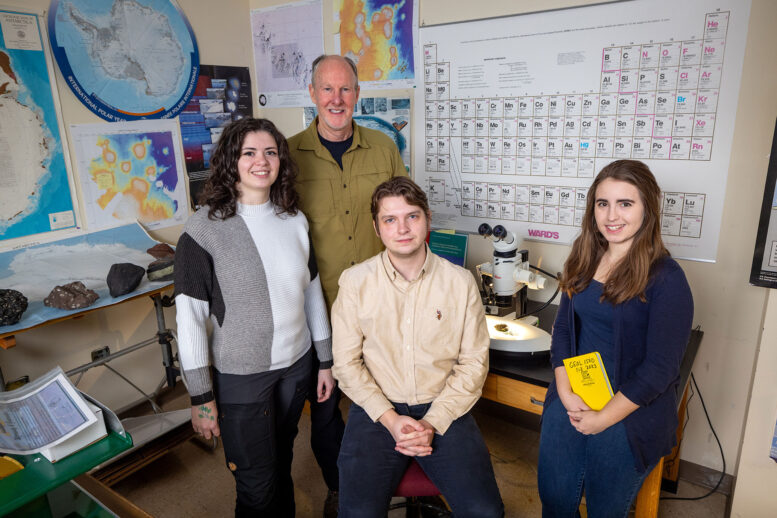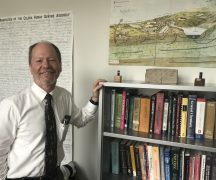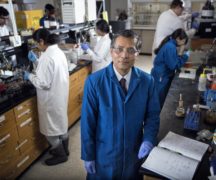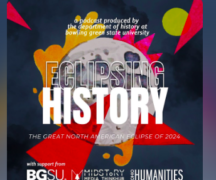From BGSU OFFICE OF MARKETING & BRAND STRATEGY
A team of scientists from Bowling Green State University are currently en route to Antarctica in search of groundbreaking new data that could play a key role in the future of climate research.
Most people know Antarctica for its brutally cold temperatures, but it carries a special distinction among geologists as one of the most volcanically significant places on Earth.
To advance scientific understanding of the region’s volcanoes, Dr. Kurt Panter, professor of geology, and graduate students Katie Shanks and Jacci Kalemba will spend approximately 60 days aboard the Nathaniel B. Palmer, an icebreaking research vessel, in the Ross Sea conducting shipboard surveys of how undersea volcanoes there impact critically important ice in western Antarctica.
Meantime, BGSU graduate student Robert O’Conke will streamline the team’s data analysis efforts stateside.
“I think most people view Antarctica as this frozen wasteland, so when you tell people there are not only volcanoes, but active volcanoes, people say, ‘Well, how can that be?’” Panter said. “It’s often disconnected from the climate we can see at the surface, but as I say, there is a lot of recent study about how volcanoes are affected by climate, particularly how thick ice is and how fast it accumulates or melts away.”
Supported by a $360,000 National Science Foundation award, the big picture of the research is to better understand the interaction between the lithosphere, hydrosphere and cryosphere – how volcanoes, ice and the surrounding ocean co-exist.
O’Conke, who hails from Chardon, Ohio, said gathering data on one the least understood parts of Earth will be critical for future research into the region.
“There are so few areas that are like the Ross Sea,” he said. “Having this dataset for such a unique area will be invaluable data as we continue to study how these three systems interact.”
Simply gathering data in an inhospitable place will be an adventure for the roughly 50 total people aboard the ship as they scrape the ocean floor, date rock samples, map the area, measure volcanic growth, collect photographs and video, measure temperatures and search for hydrothermal vents and aquatic life that relies upon them.
BGSU is one of just three American universities represented on the ship, on which scientists from many different disciplines will brave the elements to collaborate the overarching and individual projects.
“I think it’s a great opportunity to learn how professional scientists all function, especially in such close proximity where everyone has a common goal,” said Shanks, a Bowling Green native. “You all collaborate on something even though everyone is doing something within their specialty. I’m very much looking forward to seeing how all these professionals function together and knowing I get to be a part of that.”
The trip has a variable that very little geological study does: the area is virtually untouched by human activity.
Kalemba, who came to BGSU from Cleveland, said simply being in a place in which humans do not live provides a key window into how the Earth behaves.
“Typically, when you’re studying something in Antarctica and you discover something occurs naturally, you can translate that to areas where people live,” Kalemba said. “We can better understand how the Earth naturally interacts without people being involved.”
The part of the Ross Sea the ship will enter previously was covered by ice, which is being impacted by warming water underneath the surface. But because Antarctica is so challenging to study, the seafloor area simply hasn’t been mapped frequently or well.
The area in which researchers will study has seen dramatic fluctuations in ice levels over time, but scientists aren’t sure how fast the changes happened, or which variables proved most important.
“The area we’re studying was once filled with ice, which we know because the sea floor shows striations and areas where the ice plowed through and left deposits,” Panter said. “We want to understand how those features relate to volcanic activity on the sea floor because volcanics and heat from the ocean bottom can obviously melt the ice sheets.”
The burning question is whether volcanoes directly contributed – and how much they could contribute in the future – to ice loss in a critical part of western Antarctica.
“How much of that instability is due to volcanism, which relates not only to the volcanoes themselves, but also the character of the crust?” Panter said. “Understanding how volcanoes, the related geothermal energy in the crust, the underlying processes affects the stability of ice sheets can give climate modelers the ability to judge how much heat is contributed by volcanism, which should then be put into their models.”
The Ross Sea is one of the least understood parts of the globe, but one that could have major implications for future research.
For Panter, who is making his 11th trek to Antarctica, the chance to return there is filled with not only purpose, but a sense of adventure to learn something new.
“Even though it’s minimally explored, these are some important, major hypotheses that we’re about to test,” Panter said. “That’s the beauty of Antarctica, to me – going to the unknown and hoping to make new discoveries.”





